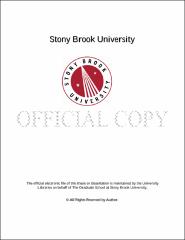| dc.identifier.uri | http://hdl.handle.net/11401/76854 | |
| dc.description.sponsorship | This work is sponsored by the Stony Brook University Graduate School in compliance with the requirements for completion of degree. | en_US |
| dc.format | Monograph | |
| dc.format.medium | Electronic Resource | en_US |
| dc.language.iso | en_US | |
| dc.publisher | The Graduate School, Stony Brook University: Stony Brook, NY. | |
| dc.type | Dissertation | |
| dcterms.abstract | Tinnitus means objective somatosounds, and subjective auditory or sensorineural perception of noise without external physical sounds. There are several tinnitus treatments, but it is difficult to ascertain how otorhinolaryngologists rank the alternatives of treatments due to the insufficiency of available evidence and standards. A hierarchical decision model (HDM), a popular multi-criteria decision analysis (MCDA) method, can help to implement a comprehensive assessment of tinnitus treatments and rational decision-making to select the appropriate tinnitus treatments. The HDM considers a holistic approach using multiple dimensions, criteria and expert judgments to acquire the relative ranking of candidate tinnitus treatments. The four dimensions selected by experts for the study of tinnitus are diagnostic categories, clinical evaluation, duration and efficiency (DCDE). The purpose of this dissertation research is to perform a case study using the initial and intermediate HDM frameworks for comprehensive tinnitus treatment assessment (TTA) with qualified decision makers: Korea’s otorhinolaryngologists with a specialty in tinnitus. The verified HDM (v-HDM) consists of the DCDE dimensions and their associated criteria. A research instrument is designed to obtain expert judgments from the otorhinolaryngologists. The expert judgments are then used to rank the dimensions, criteria and alternatives of candidate tinnitus treatments in the HDM. The alternatives are also assessed directly with respect to the mission, dimension and criterion. The results of expert judgment quantification are indicated by treatment values, which range from 0 to 100. The HDM is employed for an interdisciplinary medical decision model to establish DCDE multidimensional standards for tinnitus treatment assessment (TTA). | |
| dcterms.abstract | Tinnitus means objective somatosounds, and subjective auditory or sensorineural perception of noise without external physical sounds. There are several tinnitus treatments, but it is difficult to ascertain how otorhinolaryngologists rank the alternatives of treatments due to the insufficiency of available evidence and standards. A hierarchical decision model (HDM), a popular multi-criteria decision analysis (MCDA) method, can help to implement a comprehensive assessment of tinnitus treatments and rational decision-making to select the appropriate tinnitus treatments. The HDM considers a holistic approach using multiple dimensions, criteria and expert judgments to acquire the relative ranking of candidate tinnitus treatments. The four dimensions selected by experts for the study of tinnitus are diagnostic categories, clinical evaluation, duration and efficiency (DCDE). The purpose of this dissertation research is to perform a case study using the initial and intermediate HDM frameworks for comprehensive tinnitus treatment assessment (TTA) with qualified decision makers: Korea’s otorhinolaryngologists with a specialty in tinnitus. The verified HDM (v-HDM) consists of the DCDE dimensions and their associated criteria. A research instrument is designed to obtain expert judgments from the otorhinolaryngologists. The expert judgments are then used to rank the dimensions, criteria and alternatives of candidate tinnitus treatments in the HDM. The alternatives are also assessed directly with respect to the mission, dimension and criterion. The results of expert judgment quantification are indicated by treatment values, which range from 0 to 100. The HDM is employed for an interdisciplinary medical decision model to establish DCDE multidimensional standards for tinnitus treatment assessment (TTA). | |
| dcterms.available | 2017-09-20T16:51:19Z | |
| dcterms.contributor | Shin, Jung Eun (Grace) | en_US |
| dcterms.contributor | Sheikh, Nasir Jamil | en_US |
| dcterms.contributor | Son, Eun Jin | en_US |
| dcterms.contributor | Ferguson, David L. | en_US |
| dcterms.contributor | Im, Gi Jung | en_US |
| dcterms.contributor | Kim, Young Shin (Aaron). | en_US |
| dcterms.creator | Ihn, Hong Don | |
| dcterms.dateAccepted | 2017-09-20T16:51:19Z | |
| dcterms.dateSubmitted | 2017-09-20T16:51:19Z | |
| dcterms.description | Department of Technology, Policy, and Innovation | en_US |
| dcterms.extent | 201 pg. | en_US |
| dcterms.format | Monograph | |
| dcterms.format | Application/PDF | en_US |
| dcterms.identifier | http://hdl.handle.net/11401/76854 | |
| dcterms.issued | 2016-12-01 | |
| dcterms.language | en_US | |
| dcterms.provenance | Made available in DSpace on 2017-09-20T16:51:19Z (GMT). No. of bitstreams: 1
Ihn_grad.sunysb_0771E_13083.pdf: 4222293 bytes, checksum: 38ebe900d2301fc4b7dee94a17139c5b (MD5)
Previous issue date: 1 | en |
| dcterms.publisher | The Graduate School, Stony Brook University: Stony Brook, NY. | |
| dcterms.subject | Medicine -- Information technology -- Health care management | |
| dcterms.subject | expert judgment quantification, health informatics, health Information Technology (IT), health innovation & care, health policy, medical decision model, tinnitus treatment assessment (TTA), tinnitus management (TM) | |
| dcterms.title | A Medical Decision Model for Tinnitus Treatment Assessment | |
| dcterms.type | Dissertation | |

